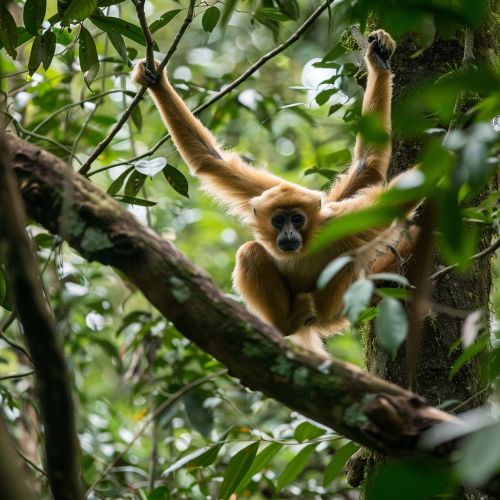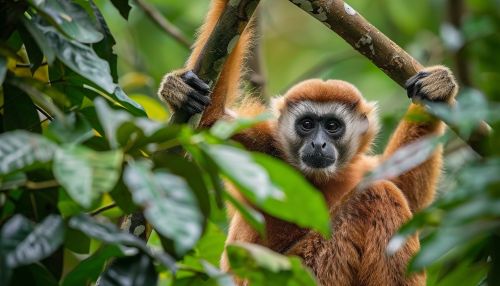Gibbon
Introduction
The gibbon is a small ape belonging to the family Hylobatidae. Known for their agility and distinctive vocalizations, gibbons are native to the tropical and subtropical rainforests of Southeast Asia. This article delves into the taxonomy, anatomy, behavior, habitat, and conservation status of gibbons, providing a comprehensive understanding of these fascinating primates.
Taxonomy and Evolution
Gibbons are classified under the family Hylobatidae, which is further divided into four genera: Hylobates, Hoolock, Nomascus, and Symphalangus. These genera encompass a total of 18 species. The evolutionary history of gibbons is complex, with fossil records indicating their presence in Asia as far back as the Miocene epoch.
Genera and Species
- **Hylobates**: This genus includes the most species, such as the lar gibbon (Hylobates lar) and the agile gibbon (Hylobates agilis).
- **Hoolock**: Contains species like the western hoolock gibbon (Hoolock hoolock) and the eastern hoolock gibbon (Hoolock leuconedys).
- **Nomascus**: Known for species such as the northern white-cheeked gibbon (Nomascus leucogenys) and the southern yellow-cheeked gibbon (Nomascus gabriellae).
- **Symphalangus**: Includes the siamang (Symphalangus syndactylus), the largest of the gibbons.
Anatomy and Physiology
Gibbons exhibit several anatomical adaptations that facilitate their arboreal lifestyle. Their long arms, hook-shaped hands, and powerful shoulder muscles enable them to brachiate efficiently through the forest canopy.
Skeletal Structure
The skeletal structure of gibbons is highly specialized for brachiation. Their elongated forelimbs and reduced thumb size allow for a greater range of motion. The shoulder joint is particularly flexible, enabling swift and agile movements.
Vocal Apparatus
Gibbons are renowned for their loud and complex vocalizations, which are produced using an enlarged throat sac. This sac acts as a resonating chamber, amplifying their calls, which can travel over long distances. These vocalizations play a crucial role in territory defense and mate attraction.


Behavior and Social Structure
Gibbons are predominantly monogamous, forming strong pair bonds that last for many years. They are territorial animals, with each family group defending a specific area of the forest.
Social Organization
A typical gibbon group consists of a mated pair and their offspring. These groups are highly cohesive, engaging in mutual grooming and coordinated vocal duets. The duets serve both to strengthen the pair bond and to assert territorial boundaries.
Communication
In addition to vocalizations, gibbons use a variety of visual and tactile signals to communicate. Facial expressions, body postures, and grooming behaviors are all integral to their social interactions.
Habitat and Distribution
Gibbons inhabit the dense tropical and subtropical rainforests of Southeast Asia, including countries such as Thailand, Malaysia, Indonesia, and Vietnam. They prefer primary forests with a continuous canopy, which provides ample opportunities for brachiation.
Range and Habitat Preferences
Different species of gibbons have varying habitat preferences. For instance, the lar gibbon is found in a wide range of forest types, from lowland rainforests to montane forests, while the siamang prefers higher elevations.
Diet and Feeding Behavior
Gibbons are primarily frugivorous, with fruits making up the bulk of their diet. However, they also consume leaves, flowers, and insects to supplement their nutritional intake.
Foraging Strategies
Gibbons employ a variety of foraging strategies, including selective feeding on ripe fruits and opportunistic consumption of insects. Their keen sense of sight and spatial memory aid in locating food sources.
Reproduction and Lifespan
Gibbons have a relatively slow reproductive rate, with females giving birth to a single offspring every 2-3 years. The gestation period lasts about seven months, and the young are dependent on their mothers for an extended period.
Parental Care
Both parents are involved in the care of the offspring, with the mother providing the majority of the nurturing. The father plays a role in protecting the family group and assisting in territory defense.
Conservation Status
Many gibbon species are currently facing significant threats due to habitat loss, hunting, and the illegal pet trade. Several species are listed as endangered or critically endangered by the International Union for Conservation of Nature (IUCN).
Threats
- **Habitat Destruction**: Deforestation for agriculture, logging, and infrastructure development is the primary threat to gibbon populations.
- **Hunting and Poaching**: Gibbons are hunted for their meat and captured for the illegal pet trade.
- **Climate Change**: Alterations in climate patterns can affect the availability of food resources and suitable habitats.
Conservation Efforts
Efforts to conserve gibbons include habitat protection, anti-poaching measures, and captive breeding programs. Organizations such as the Gibbon Conservation Alliance work to raise awareness and implement conservation strategies.
